On a wet Paris night of driving rain, in a match of Shakespearean drama with a slippery field and ball that made handling and running difficult, a superbly coached and motivated crazy brave Springboks side defeated a resilient but careless All Blacks side 12-11, four penalties to an unconverted try and two penalties, before a crowd of 86,085 spectators, that often booed them, to win the 2023 Rugby World Cup tournament.
The Springboks have now won four RWC titles – 1995, 2007, 2019, and 2023 – in the eight tournaments that they have competed in since 1995. No team is ever going to beat this record of winning half the RWC tournaments they have played. Except themselves, perhaps, if the Springboks win the Webb Ellis trophy in the 2027 RWC tournament to be played in Australia.
Two of those finals were against the All Blacks: RWC 1995 when Nelson Mandela electrified the Ellis Park crowd and the Springboks by coming on to the field in the Springbok jersey for a pre-match greeting of both teams: and on Sunday morning (EST) when they withstood a second half fight back by the All Blacks and showed nerveless gamesmanship in running down the clock in the last scrum of the match.
Remarkably, too, the Springboks won all their finals matches in this tournament by a one point margin: 29- 8 against France, 16-15 against England, and now 12-11 against New Zealand.
The 2019-2023 Springboks, winners of two Webb Ellis trophies and a series victory over the British and Irish Lions stands now in Rugby’s Hall of Fame as one of the greatest teams in the history of the game.
The way the Springboks defended in the second half of the final, especially after the All Blacks scored an unconverted try to take the score to 12-11 at the 55th minute, and led by Pieter-Steph du Toit whose 28 tackles for the match including two smashing efforts in the last quarter on Jordy Barrett, was a hard-shouldered reminder that tournaments like the RWC are won by defence.
This intense, generally accurate defence by the Springboks, they missed only 18 tackles out of 245 attempted, even featured a series of hard-driving tackles by the smaller players like winger Cheslin Kolbe, who lifted All Blacks danger-man Will Jordan off the ground twice before dumping him like a garbage bag to the ground.
Pieter-Steph du Toit made 28 tackles in the match, several of them bone-crunches on Jordie Barrett like a tank hitting a lamp post, the equal highest ever tackle count in a RWC final.
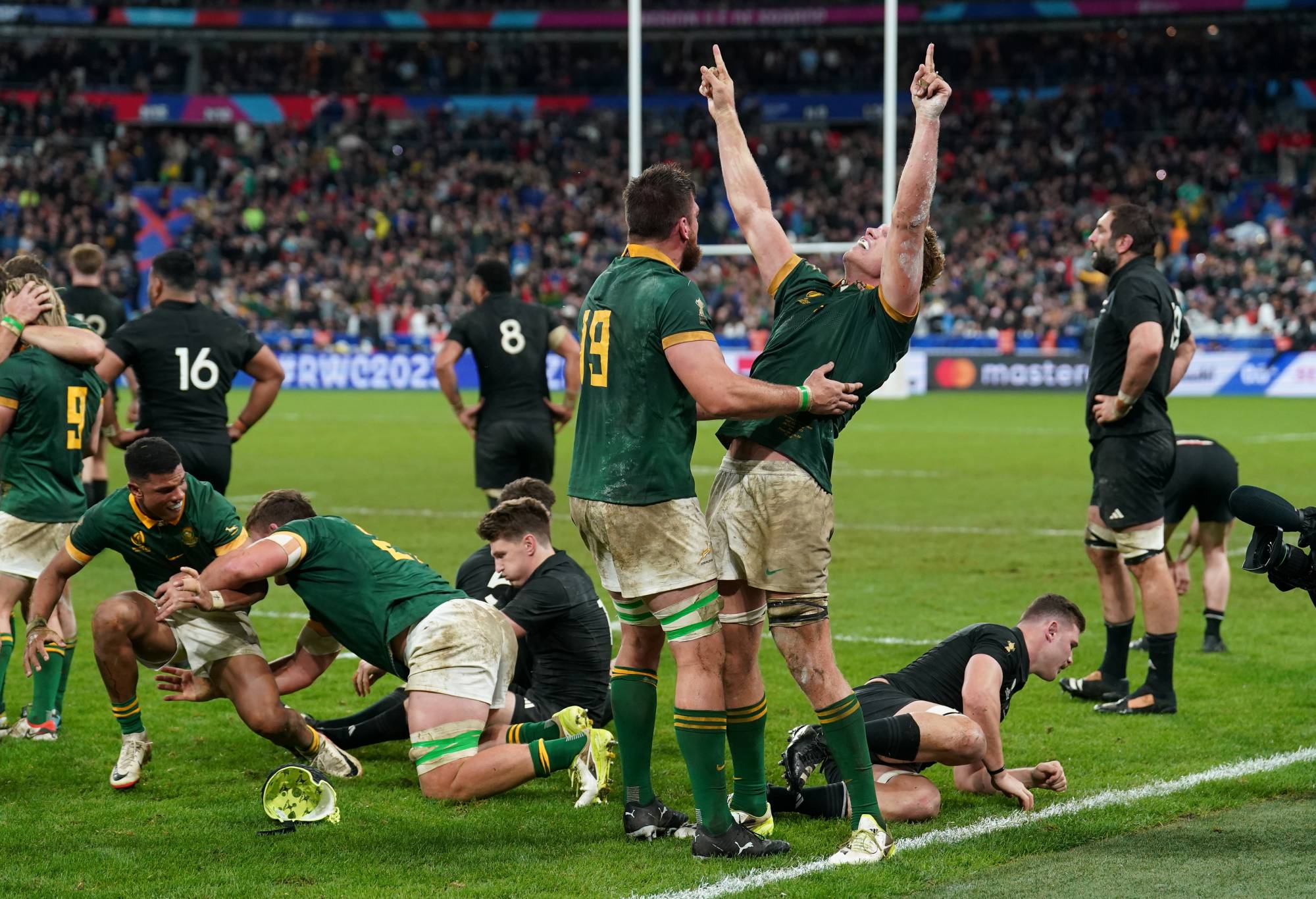
South Africa’s Jean Kleyn (left) and Pieter-Steph Du Toit celebrate victory (Photo by David Davies/PA Images via Getty Images)
The Planet Rugby statistics show that every South African forward (except for the injured Bongi Mbonambi) were in double figures in their tackle count. These forwards, too, forced 18 turnovers which in turn slowed down the All Blacks ruck speed to 5.05 seconds, a second slower that the All Blacks average for the tournament.
The Bomb Squad tactic, then, had the effective of nullifying the All Blacks 60 per cent possession by making this slow possession that made it difficult for any consistent series of attacks to be mounted. The oldest and wisest rugby adage is this: the team that controls the advantage line wins the match.
This defensive master-class has its origins in the 1995 RWC final when arguably the most potent winger of all time, Jonah Lomu in his prime after a stupendously outrageous four tries against England in the semi-final when opponents were skittled as if they were bowling pins, was smothered and often shepherded into touch by groups of fired-up Springboks defenders.
A similar hounding pack of tacklers at Paris stopped the All Blacks’ successor to Lomu, Will Jordan, from making any breaks. This aggressive tackling forced Jordan to kick, unfortunately long and not kick-and-chase chips which would have been more effective. Towards the end of the game when the All Blacks were behind by a single point, Jordan was inexplicably replaced by Anton Lienart-Brown.
Before the final a New Zealand newspaper ran this headline: ‘Rugby World Cup: Method against madness – All Blacks stand one step from greatness.’
This was more a sub-editor’s beat-up in over-egging the comments that the author of the article, Marc Hinton, had written about the challenge facing the All Blacks in ‘dealing with seven hulking Springboks coming their way over a second half of a World Cup final that is sure to stretch the very fibre of their being.’
The hulking seven referred to were the seven forwards named on the Springboks substitute bench.
This seven forwards and one back substitute split, presumably the ‘madness’ in the headline, was contrasted with the traditional ‘method’ of a 5 forwards and 3 backs split announced by the All Blacks selectors.
The fact is that there is a obvious method behind the Springboks reserves split. I call this method ‘crazy brave,’ taking this description from the title of Joy Harjo’s memoir of her journey through her life from a troubled childhood to becoming a poet and a musician. Harjo says that this crazy brave journey is her story of ‘resilience, self-discovery, and finding her voice.’
This is exactly what the 7-1 split created for the Springboks. It forced the Springboks to be resilient, go to the edges and over of their reserves of energy and courage and find their voice in the common cause of winning at any cost.
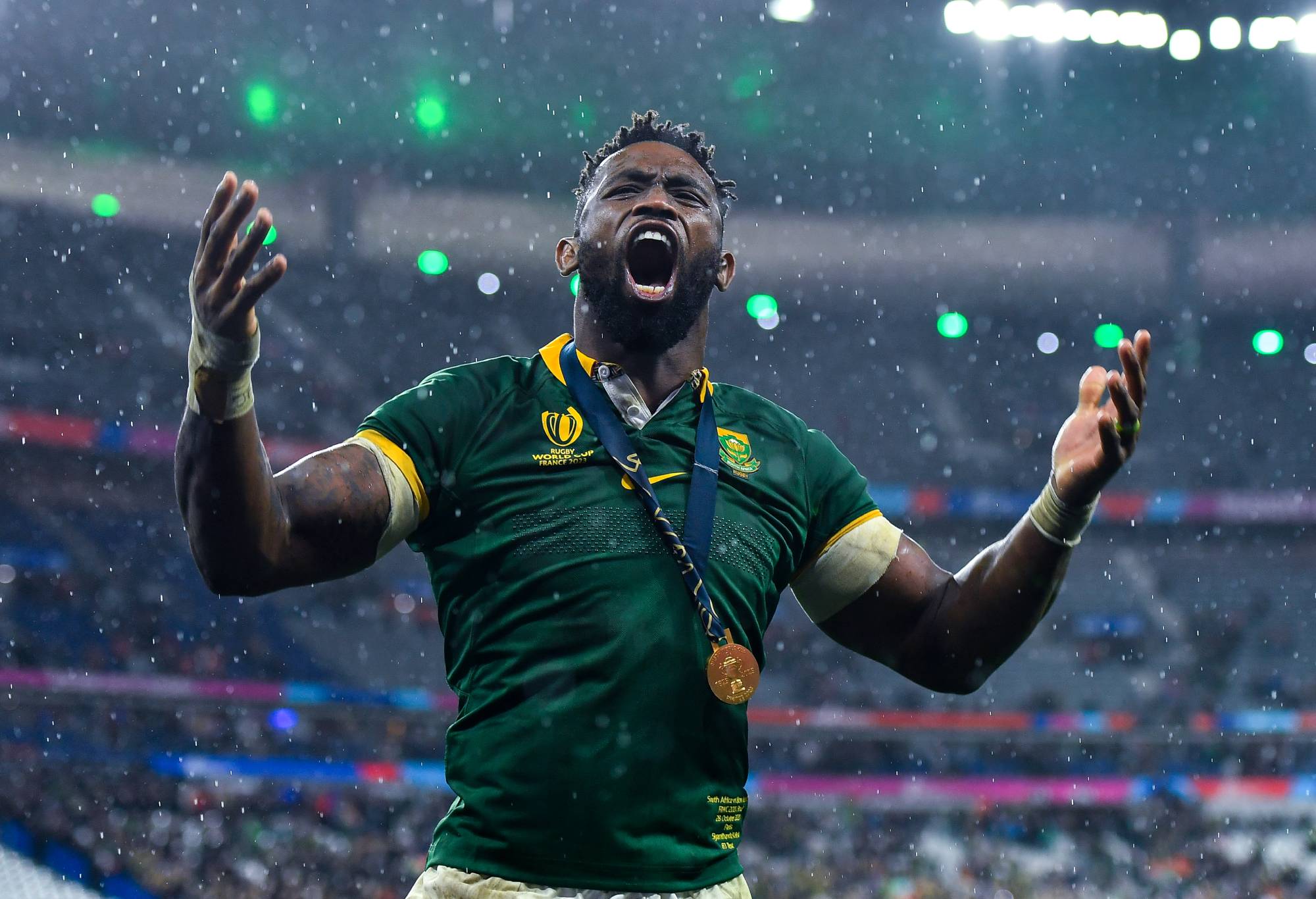
Siya Kolisi of South Africa celebrates at full-time after their team’s victory during the Rugby World Cup France 2023 Gold Final match between New Zealand and South Africa at Stade de France on October 28, 2023 in Paris, France. (Photo by Franco Arland/Getty Images)
The Bomb Squad tactic enabled their great traditional scrumming strength. With the 7-1 split the team knows that it has two essentially separate packs available to the coaches to bring on when it is deemed necessary. Dominance in the scrums leads to penalties and the Springboks have won their RWC finals, especially the last two, by the goal-kicking accuracy of kickers like Handre Pollard.
As Simon Poidevin pointed out in an excellent match analysis for The Australian Financial Review, ‘history tells us that points from kicks win RWC finals – in the period from 1987 to 2019, 29 per cent of points in finals came from tries and 71 per cent from kicks.’
At the Stade de France, Handre Pollard kicked all four of his penalty shots at goal. The All Blacks by comparison missed several penalties and a conversion.
The scrum then is the talisman for Springbok teams in must-win matches like RWC finals. There is an historical imperative behind this talisman.
This talisman tradition started in the build-up to the last Test of the All Blacks – Springboks series at Eden Park in 1937, where the winner would win the series. Paul Roos, the captain of the famous 1906 Springboks to Europe, sent a telegram to his successors before the Test: ‘Scrum, South Africa, scrum, scrum, scrum.’
At that time, teams could opt to scrum instead of throwing into a lineout. Philip Nel, the Springboks captain, after the All Blacks had kicked for touch the first time in the match trotted up to the mark and told the All Blacks, ‘We’ll scrum, New Zealand.’ The Springboks won the next four scrums in a row and from the last of these scrums, the backs scored a famous and winning try.
When the Springboks go into big matches they determined to scrum their opponents into the ground, they are going back to the tradition set in the Paul Roos.
The other aspect of the 1937 Springboks, dubbed by New Zealanders as ‘the greatest side ever to leave New Zealand,’ was the versatility of its players and their rugby intelligence. One example is the team’s half back, Danie Craven. Craven played Tests at No.8, No.10 as well as half back.
As ‘Doc’ Craven, with his two PhD’s in Anthropology, was one of the greatest rugby thinkers the game has known. He wrote books on rugby theory. He was behind the creation of the 3-4-1 scrum which he had to teach to the 1949 All Blacks in South Africa.
And at his university at Stellenbosch trialled all sorts of variations to the rugby laws. He told me once in an interview that the laws of rugby are ‘wrong’ because they can’t be written on a single sheet of paper like the football laws.
These qualities of versatility and deep thinking about the possibilities of the game have been used by the current Springboks coaches in the tradition of 1937 and Danie Craven, then. The 7-1 split relies on a number of players being able to play, and play well, in several positions. This versatility of many of the current Springboks has not been understood by many rugby writers when analysing the tactics the Springboks used to win the 2023 RWC tournament.
Take the reserve hooker Deon Fourie. He has had a long career as a journeyman loose forward and hooker and as an international Sevens player in 2007. Aged 37 he is the oldest new Springbok.
He is small for a hooker or a modern loose forward with a height of 1.75 cm and weighing 96 kg. But he came on as hooker in the third minute of the game. He was the centrepiece of a scrum that held its own throughout the match.
And in the loose he played like with energy and power at the breakdown that enabled the coaches to hold back Kwagga Smith as their cover for any injured winger.
The Springboks coaching staff explained, too, that the 7-1 split was not a risk because they had players like Cheslin Kolbe who could cover halfback and probably No. 10 and fullback based on his play in the final: Pollard could cover the inside centre position: Damian Willemse could play as a No. 10 or winger: Willie le Roux, the only back reserve, could cover any number of positions in the backline: and Kwagga Smith could play in the loose forward positions or on the wing.
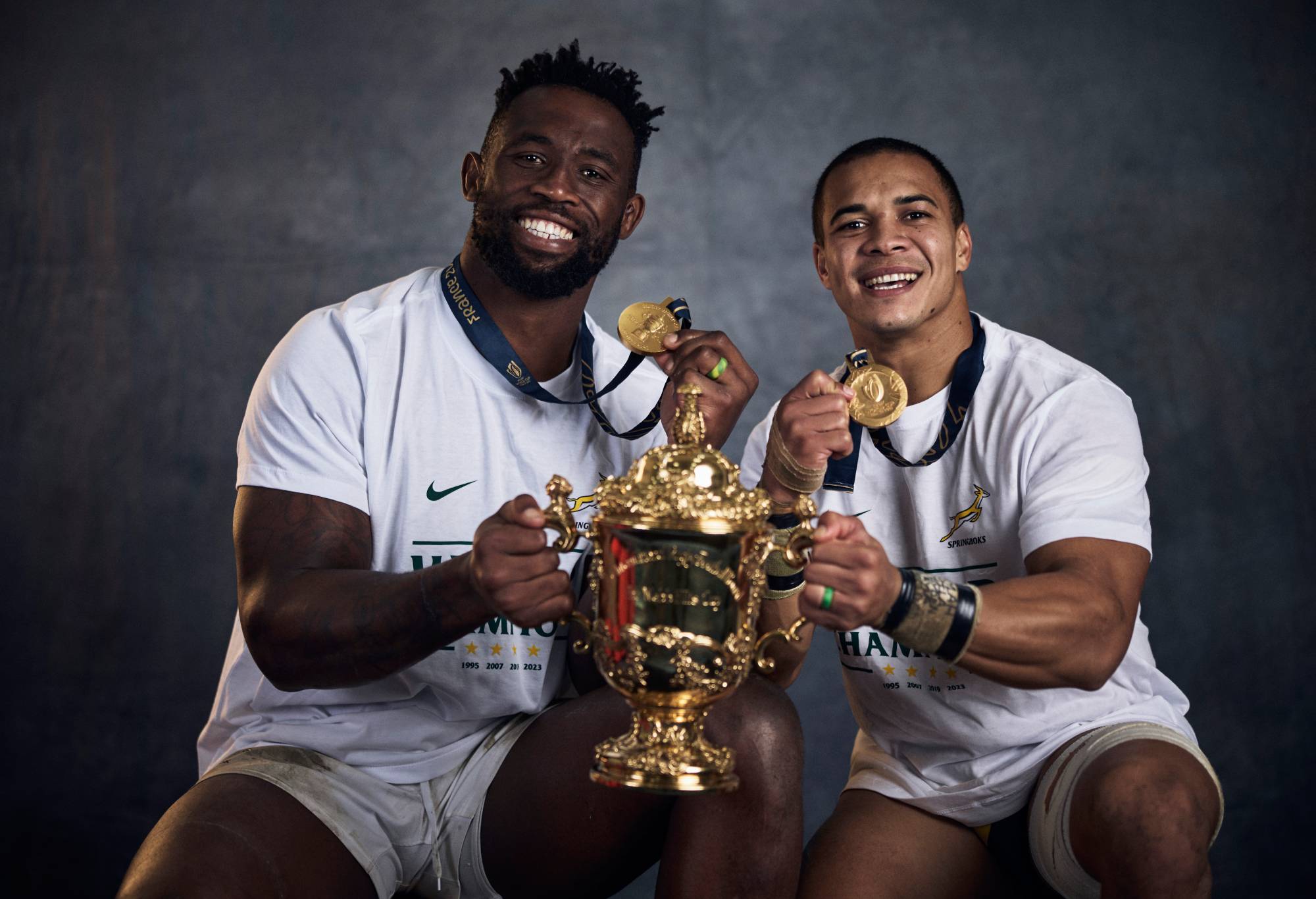
Siya Kolisi and Cheslin Kolbe of South Africa pose with the Webb Ellis Cup during the South Africa Winners Portrait shoot after the Rugby World Cup Final match between New Zealand and South Africa at Stade de France on October 29, 2023 in Paris, France. (Photo by Adam Pretty – World Rugby/World Rugby via Getty Images)
The main problem with the 7- split is that it forces a game plan that necessitates winning the game the hard way through not scoring tries.
Despite the All Blacks playing 50 minutes of the match with 14 players, after Sam Cane was given a red card, the Springboks could not score a try and only threatened to do so late in the match when the All Blacks were running the ball from inside their 22. And if the All Blacks had kicked just one of their missed shots at goal, the Springboks would have lost.
The point here is that the All Blacks missed their crucial kicks.
The Springbok coaching staff showed mastery of their craft when their hooker Bongi Mbonambi was injured by Shannon Frizell falling on his leg in the first minutes of the game. Deon Fourie was forced to come on, 50 or minutes before he was scheduled to. Referee Wayne Barnes was told by the coaching staff that Fourie was a ‘tactical replacement.’
What this meant is that Mbonambi could come back if necessary and, more importantly, his replacement was not be counted as a replacement. The relevant law states that a tactically replaced player may return when replacing an injured front rower. The replacement was not needed. But the fact that it was there, just in case, shows how shrewdly calculated the 7-1 split has been by the Springboks coaches.
Incidentally, while Mbonambi was walking gingerly off the field, Rassie Erasmus could be seen in the coaching box, with his hand covering his mouth to prevent his lips being read, in an animated manner telling the runners on the ground something, presumably to ensure that Barnes knew that Mbonambi was a ‘tactical replacement.’
We come now to the disappointing aspect of the match, the mistakes made, in my opinion, by referee Wayne Barnes and several others made by the TMOs.
I preface this commentary by acknowledging that Barnes is the best referee in world rugby, that the laws are unduly complex and should be overhauled along the lines of the ELVs, something an obdurate and feckless World Rugby has refused to do.
Much of the information in this section but not all of it comes from an article on Stuff, a New Zealand news website, written by Aaron Goile and titled: ‘Rugby World Cup 2023 referee review: Was Wayne Barnes really that bad in the final?’
3rd minute – Shannon Frizell yellow card
Shannon Frizell fell on the leg of Bongi Mbonambi an incident that Wayne Barnes appeared to not notice, even though it was in clear view when it happened.
The TMO intervened, while Mbonambi was being assessed and walked off injured, and told Barnes that Frizell did ‘not attempt to roll’ Mbonambi out of the way and ‘dropped his weight onto an exposed leg.’
Faced with this interpretation of what happened by the TMO, Barnes had no option but to hand out a yellow card.
The Law 9.20 covering this incident states that ‘a player may lever the jackler out of contest but must not drop their weight or target the lower limbs. Sanction: Penalty.’
When the TMO informs Barnes that the yellow card is not going to be upgraded to red because ‘he’s not targeting the lower leg, but he falls on to the lower leg as part of the clearout,’ the basis for the yellow card is destroyed.
In other words, Frizell was not targeting Mbonambi’s lower leg, so not even a penalty should have been awarded.
The Springboks kicked two penalties while Frizell was in the sin bin
18th minute – The apology to Ardie Savea
Barnes penalises Ardie Savea for not releasing the tackled Springbok player before jackling the ball. ‘Clear release, please, you went down on the ground,’ Barnes tells Savea.
Barnes clearly did not see Savea preventing the tackled player because Savea did make the required release.
How do we know this. Because, before the penalty shot was taken, the big screen showed the incident to the crowd, the players and the referee.
Barnes reaction was to say: ‘Sorry mate, I didn’t see the replay, I thought you stayed on him. I didn’t see it come off enough.’
Why didn’t the TMO then contact Barnes to change his decision? Why didn’t Barnes change his decision – which he did after he awarded Aaron Smith his ‘try’ in the second half? Handre Pollard kicked the penalty from this infringement.
The Cane and Kolisi High Tackles – 29th minute – Sam Cane red – 46th minute – Siya Kolisi yellow
Aaron Goile combines these two initial yellow cards to the captains of the two sides, correctly in my opinion, to contrast the different outcomes on two incidents.
He insists that the subsequent red card to Cane was the right decision. And that the Kolisi decision could have been, if the Cane precedent followed, a red card too.
This is a line that virtually all the rugby writers commenting on the final seem to have made. The yellow card for ‘direct contact’ to the head was correct. But for me, the red card part is wrong.
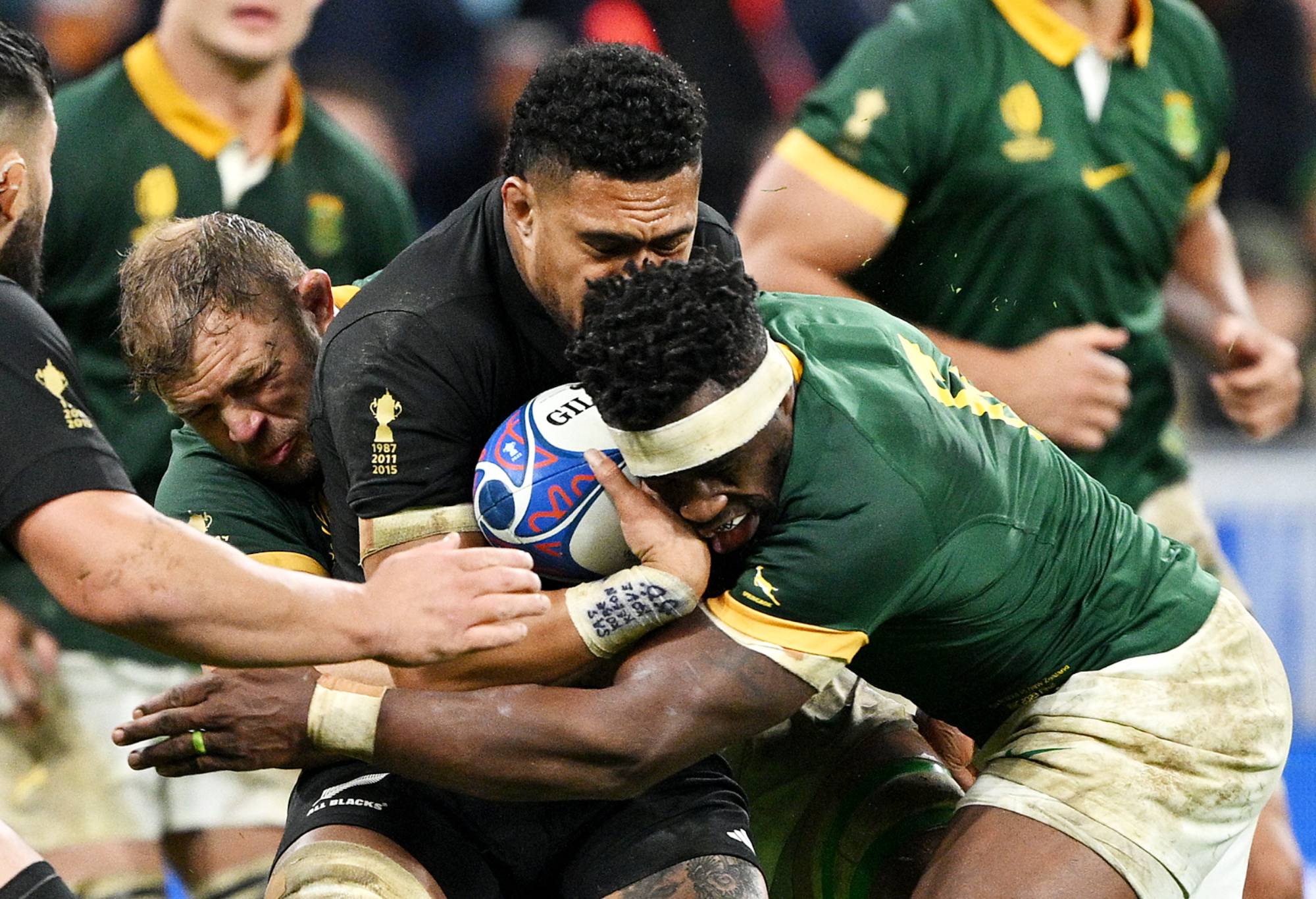
Siya Kolisi of South Africa commits a high tackle with head contact on Ardie Savea of New Zealand during the Rugby World Cup Final match between New Zealand and South Africa at Stade de France on October 28, 2023 in Paris, France. (Photo by David Ramos – World Rugby/World Rugby via Getty Images)
Cane is seen standing upright to grab Kriel in a bar hug and force a scrum inside the Springboks 22 and near enough to the middle of the field. Kriel charges into him, using his head essentially as a fend. This is one of those awkward cases, it seems to me, when the runner is more guilty of the head contact than the tackler.
The decision to convert the yellow card was taken by a group of referees in a bunker miles away from the ground, not by the TMO.
The way this transition from yellow to red operates is that the conversion to red requires a ‘high degree of danger, and no mitigation’ involved from the tackler.
Where was the ‘high degree of danger’ in the Cane tackle? There was no dropped shoulder. Kriel was not smashed. Kriel did not even require a HIA. When the incident happened no one on the field, including Barnes, saw what the bunker seemed to see. Kriel, in fact, was the one who dropped his shoulder into Cane.
This red card meant that the All Blacks played for 50 minutes with 14 players.
It is no comfort to the All Blacks that the bunker got the Kolisi incident right. Kolisi was bent at the hips when he smashed into the head of Savea, admittedly. But his collision was much more violent than Cane’s but did not go close to a red card offence.
80th minute – Springboks’ scrum reset
When the final scrum on the match was being set there was 79 minutes 31 seconds on the clock. By the time Barnes called ‘set,’ Aaron Goile notes, the clock was set at 79 minutes 45 seconds. ‘The packs were steady for a good five seconds,’ Goile writes. ‘Yet the Springboks halfback Faf de Klerk failed to put the ball in, as the All Blacks were putting on good scrum.’
Goile states the relevant law: Law 19.15 (Scrum – Throw) When both sides are square, stable and stationary, the scrum-half throws in the ball … Without delay. Sanction: Free kick.
Five seconds is the time allowed for a halfback clear the ball from a ruck when he has his hands on it.
Barnes should have given a short arm penalty to the All Blacks. We will never know because of this Barnes decision not to make a decision if the All Blacks had it in them to convert this free kick, not far from the Springboks try line, into points to win the final.
When de Klerk feed the next scrum at 79 minutes 53 seconds on the clock, he did so in two seconds.
The All Blacks big shove forced a turnover maul from the Springboks but tome was up. De Klerk’s great gamble paid off.
Fortune favours the crazy brave
There were two more incidents, both involving Eben Etzebeth, where the Springboks somehow got away with play that should have exposed Etzebeth to two yellows and, therefore, a red card.
There’s a photo, clearly taken early in the final, of Etzebeth with the ball in one arm using his right forearm to whack Sam Cane’s jaw directly.
Where were the TMO officials on this incident?
Etzebeth’s action was clearly yellow card material. And given the bunker’s decision on Cane probably a red.
The importance of this mistake by the TMO officials becomes monstrous when we realise that not long after this Cane was given his red card.
In the 36th minute of play the All Blacks were mounting a series of running plays near the Springbok’s 22. For once they were getting quick ruck ball and the Springboks defence was scrambling to stay intact. A charge is made by the All Blacks that gets behind the defensive line.
The Springboks flood back to fill in the holes in their line. By the time Aaron Smith fires off the next pass to move the ball out wide, most of the defenders are back but not settled. The pass is fired off. But what’s this, the pass hits the body of Etzebeth as the last straggler making his way back on side.
Etzebeth raises his hands as the ball hits his nicely placed (the Springboks) body as if to say, ‘what me preventing a quick recycled, no way.’
And Wayne Barnes accepts this feeble excuse. He tells Ardie Savea that Etzebeth is merely ‘running back to get back to his defensive line.’
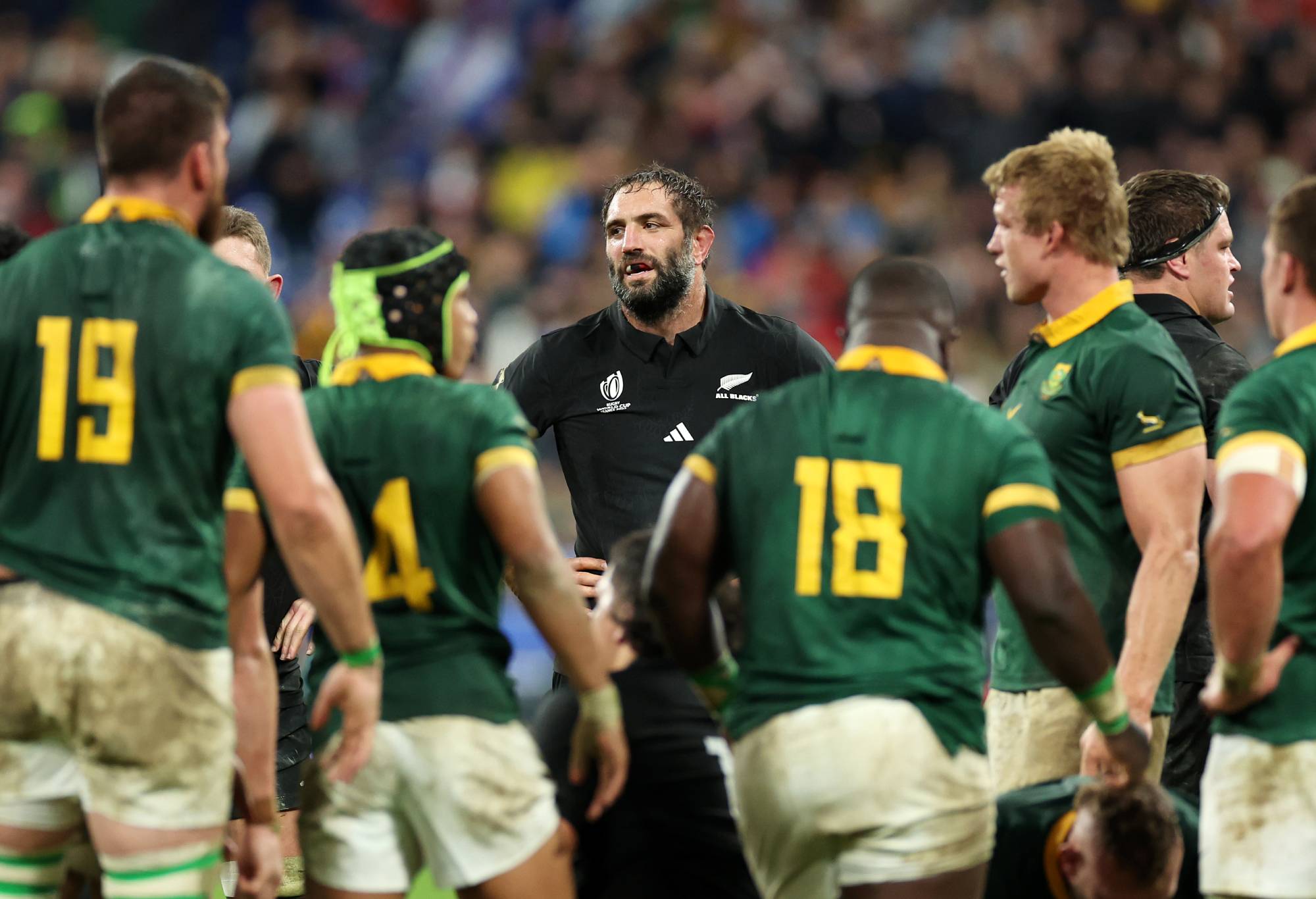
Samuel Whitelock of New Zealand looks on during the Rugby World Cup Final match between New Zealand and South Africa at Stade de France on October 28, 2023 in Paris, France. (Photo by Chris Hyde/Getty Images)
This is a disappointing ruling, to put it mildly. Etzebeth clearly timed his run to interfere with the continuing All Blacks attack. It was a clear-cut yellow card offence given that when a pass is deliberately slapped down in an attack that has the potential to lead to a try a yellow card is inevitable.
The reason why I have discussed these rulings that had a massive impact on the chances of the All Blacks winning the final is not to claim ‘We Wuz Robbed.’ It is to put into perspective the full-hearted, hard-shouldered, gutsy, and determined running game the All Blacks played to almost pull off a seemingly impossible victory.
Despite playing the match for 60 minutes with only 14 players, the All Blacks, according to statistics provided by Simon Poidevin, ‘made 143 runs to the Springboks 83, beat 36 defenders to 13, and threw a total of 217 passes to the Springboks 83, though the Springboks won the turnovers seven to three.’
Planet Rugby paid this tribute to the All Blacks and to the victors, the Springboks : ‘The All Blacks were magnificent, playing with 14 men for much of the game, most of the ambition came from their brilliant backs, but against a defence that racked up a total of 208 tackles and missed only 12 per cent of them. Territory was their enemy, forced to play from deep positions for most of the match as the Bok line speed held them back in their own half. Perhaps with that extra man things may have been different, but South Africa have made a habit of winning the tight margins and in Paris on Sunday they won the biggest one of all – the Rugby World Cup.’
For the victor, though, goes the glory.
The last word must go the inspirational Springboks captain, Siya Solisi when he explained the motivations behind the intense way he and his team have played in this RWC tournament: ‘The kids at schools are sending us clips of them singing because they know some us like singing. People at work are wearing their green jerseys, anything that is green. We see that and that will continuously be our motivation. The majority of the people in our country are unemployed and some have no homes. For me, giving up and not giving everthing would be cheating.’
The 2019 and 2023 RWC-winning Springboks have become the team for a Rainbow Country, a Team for the Ages.

































































































